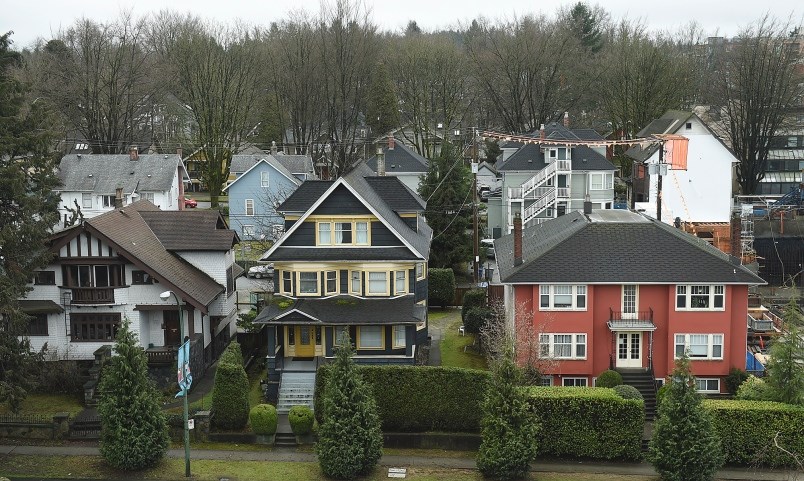The city has unveiled a multi-faceted housing plan aimed at tackling the affordability crisis in Vancouver that creates thousands of more rentals, allows for a better mix of homes and develops units that will be tied to a person’s income.
Without a shift in its current housing strategy, city officials warned at a news conference Thursday that only those people with above average incomes could afford the 47,800 homes projected to be built in Vancouver over the next 10 years.
“What we’ve been hearing is that young people and families are not able to find affordable rental opportunities and they’re also not able to find places that they would like to buy and stay in,” said Kathleen Llewelyn-Thomas, the city’s general manager of community services, at a news conference at city hall Thursday. “Our statistics are showing that families and young people are leaving Vancouver at a very high rate – an alarming rate, 20 per cent since the last census.”
Of the 47,800 new homes projected to be built, the city estimated 26,800 will be rental units. But only 2,600 of those will be affordable for single people earning less than $50,000 per year; affordability is based on a person paying no more than 30 per cent of income on housing.
Families who rent and earn under $80,000 also face a severe gap in rental housing, with 4,250 homes projected to be built in 10 years – half of what is needed, according to a city staff report on the housing plan that goes before city council next Tuesday.
The report showed a steep decline – between 2006 and 2011 -- in the proportion of young households aged 25 to 39 living in Vancouver. During the same period, numbers of young children born in Vancouver also declined once they reached school age, likely reflecting a departure of growing families in search of affordable, family-sized housing, the report said.
The city’s housing plan, which still needs more public input and staff work before being finalized by council in July, focuses on building “the right supply” of housing to meet income levels of new families and keep young people from leaving the city.
That “right supply” includes townhomes, row houses, duplexes and housing that would be legally tied to a person’s income, as worked out in a covenant between the city, the developer and tenant or buyer of a home. The target age group for such housing is people between the ages of 20 and 44, the so-called “missing middle.”
“There’s a whole toolkit of things within the land use arena and within the housing policy and financial arenas that we need to leverage, and mix and match, so there’s not a single answer there,” said Gil Kelley, the city’s chief planner, when asked how incomes could be tied to housing.
But, Kelley said, the city could choose to set a standard amount of “inclusionary housing” on any project rather than negotiating with a developer on a site-by-site basis. He said many cities in the United States adopted the approach, which ties affordable housing to a new development. Offering density bonuses to developers for a certain amount of longterm affordable housing is another option, he added.
Other initiatives proposed by city staff include launching a one-year experiment to speed up the production of affordable housing by expediting build permits, develop 1,000 affordable housing units on eight city properties, expand the city’s Rental 100 program that provides incentives to developers to build rental housing, and build more rentals around transit stations.
Average rent increase 46 per cent
The city report shows that in 2006, a young single person aged 20 to 35 earning $35,000 a year could afford the average one-bedroom rent of $868 per month in Vancouver. Rent today for that same apartment has increased 46 per cent to $1,268, which requires an income of $51,000 per year.
For families, the income required to own an East Side townhouse in 2006 was $90,000. Today, an 88 per cent increase in housing prices means a household income of more than $150,000 is needed to buy the same home.
In 2011, more than 46,000 renter households in Vancouver were spending more than 30 per cent of their income on rent. The majority of the households were in lower income brackets, the city report said.
The rent and housing increases have skyrocketed despite new housing starts – i.e. more supply to meet demand – averaging 5,000 units per year over the past decade. Vancouver saw a record year in 2016 with 9,800 new housing starts, which accounted for 35 per cent of all starts in Metro Vancouver.
“When it comes to the affordability and the tenure of housing that will come out of the supply in the next 10 years, it’s just not going to match what the community is needing,” said Llewelyn-Thomas on the reason for the city’s new housing plan.
Earlier this month, Mayor Gregor Robertson said in a speech to a crowd of about 300 developers and business people the “time is right to advance a conversation” about how the city can create more affordable housing while still preserving the essence of single-family neighbourhoods.
“We want to make sure we do this very carefully,” the mayor said in a 45-minute speech to guests and members of the B.C. chapter of the Urban Land Institute. “But at this point, we need to see change, we need to see new homes, new supply in our single-family home neighbourhoods.”
mhowell@vancourier.com
@Howellings



